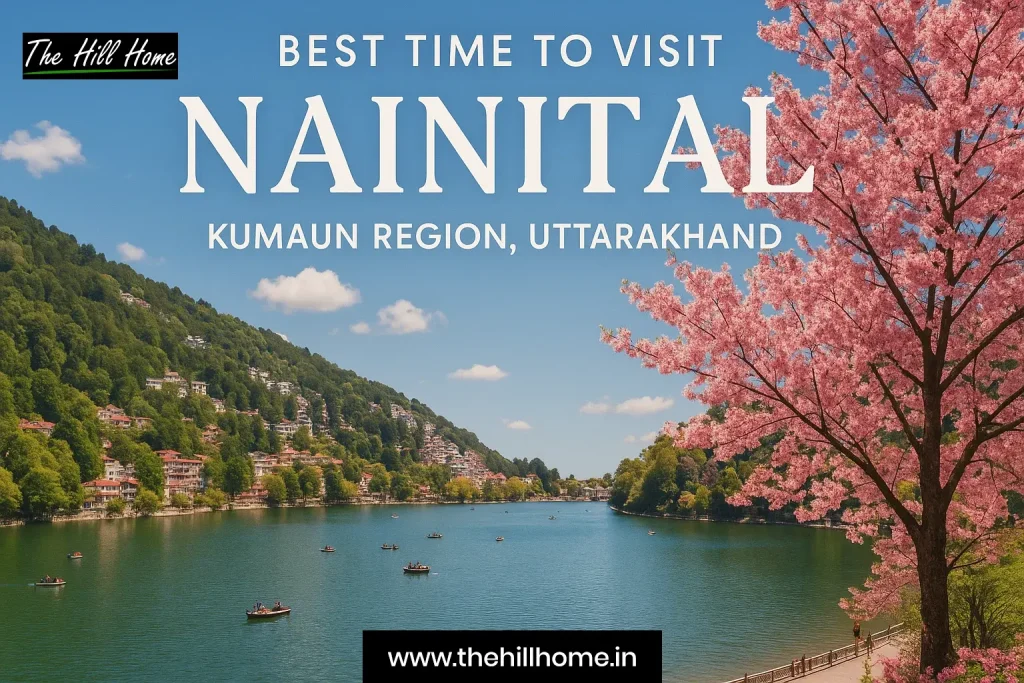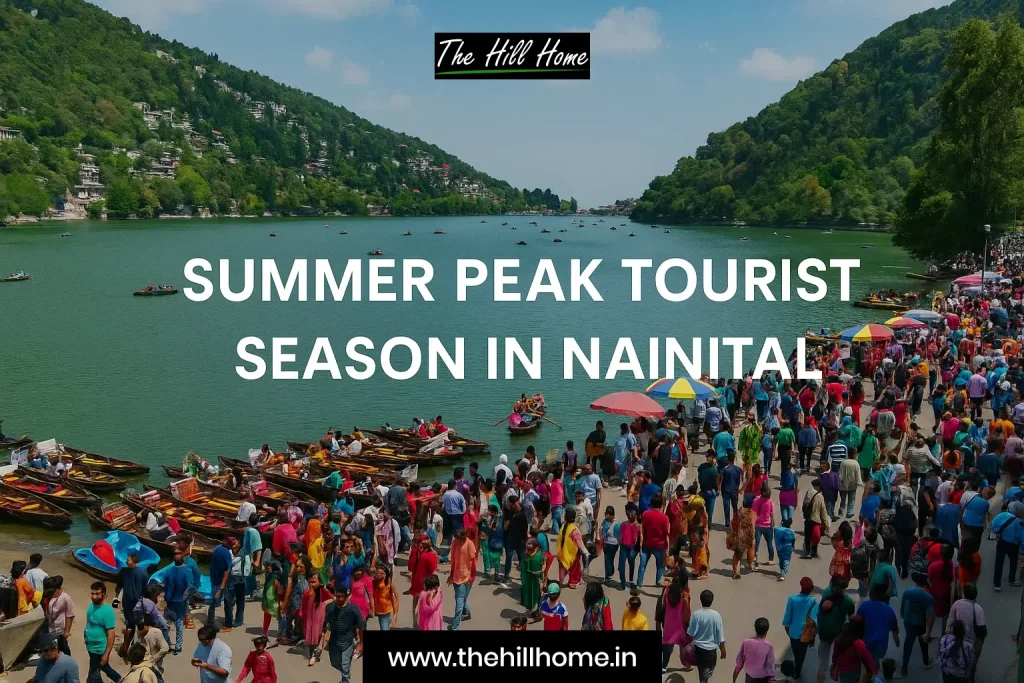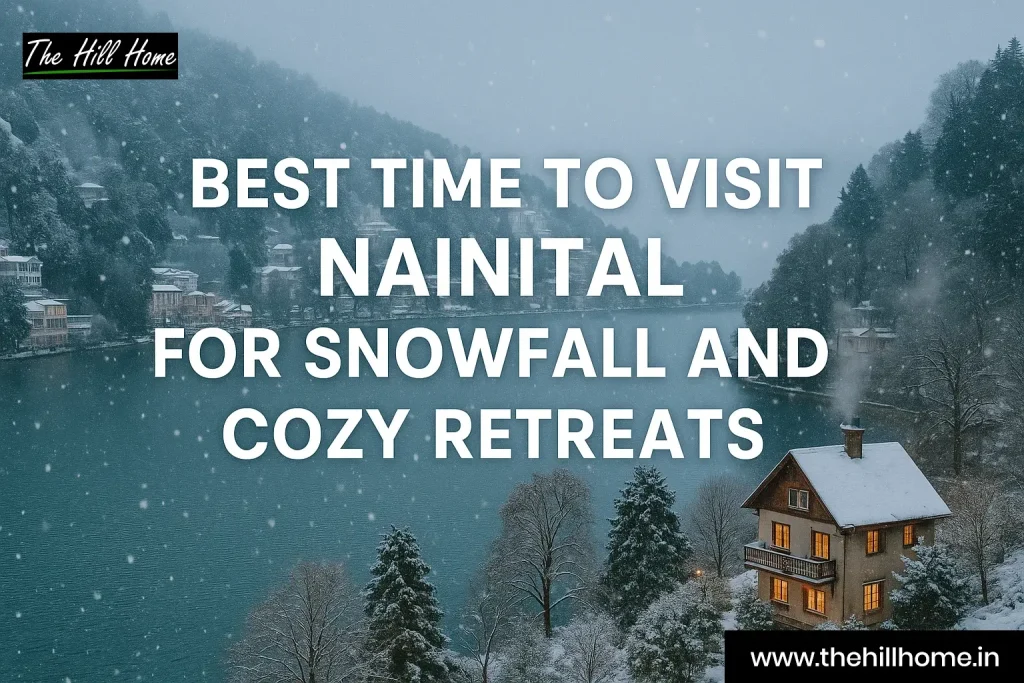Why is Nainital a Year-Round Destination?
If you are looking for a budget-friendly summer retreat, or an experience of a winter wonderland, or simply want to delve into a spectacular stretch of picturesque beauty, Nainital should be at the top of your list. Knowing the best time to visit Nainital can help with your research and find out which season would be the best for your taste.
Nainital is a popular hill station situated in the Kumaon Himalayan region known for its majestic mountains, pristine lakes and panoramic views. Perched at an average elevation of 2,084 metres above sea level, its everlasting expanse of striking beauty is something you cannot miss if you are planning to travel with your friends, family or partner.
The town is ringed around the immaculate eye-shaped Lake Naini, which is a major attraction for all tourists. You can easily enjoy the Naini Lake if you know what time is best to visit Nainital, Uttarakhand. As per Hindu mythology, it is believed that the eyes (Nain) of Goddess Sati fell in this place when Lord Shiva was carrying her body after her death, which gave this town its name.
The Naina Devi Temple, one of the 51 Shakti Peethas sacred to Hindus, is a significant pilgrimage site located at the northern end of the lake. The lake is also surrounded by some of the highest peaks such as Naina Peak (2,615 metres), Deopata (2,438 metres), Ayarpata (2,278 metres) and Snow View Point (2,270 metres), all of which are popular tourist attractions.
The place is also a hotspot for all the adventure seekers out there who know the best times to go to Nainital. This place offers various recreational opportunities such as boating in the Naini Lake, sightseeing at Snow View Point, and trekking down the Nainital-Binayak and Nainital-Kilbury trails. With its temperate and pleasant climate with wide-ranging attractions available all year-round, Nainital has something to offer for people of all ages and diverse interests.
Which is the Best Time to Visit Nainital? Overview of Nainital’s Weather and Climate
Nainital experiences a temperate and pleasant climate throughout the year. With each seasonal change, the ultimate experience offered by the town varies.
Summers, typically from March to June, are pleasant and slightly warm with temperatures ranging from 10°C to 25°C. It is the most sought after time for visiting Nainital as the weather conditions are ideal for sightseeing and outdoor activities.
The Monsoon season, generally from July to September, teems with frequent rain showers and a windy, cool climate. The temperature ranges from 15°C to 25°C during this time. The whole panorama is vibrant and lush with greenery making it perfect for a nature walk in solitude. However, there are high risks of flash floods and landslides which can hinder any plans for outdoor activities.
Autumn can be experienced in the months of October and November when the air is crisp and cool. The temperatures can drop slightly ranging from 5°C to 20°C. This time is ideal to visit Nainital especially for those long hikes and treks amidst the fall foliage.
The months from December to February experience jarring Winters, with temperatures dropping to 0°C or even lower. The town is serene and blanketed with snow, making it a winter paradise. The site of the majestic snow-capped Himalayas is breathtaking, and it is during this time that all the snow lovers can experience activities like skiing, ice-skating, snowboarding, etc.
Table: Weather Conditions Throughout the Year in Nainital
| Months | Jan | Feb | Mar | April | May | June | July | Aug | Sept | Oct | Nov | Dec |
| Average Monthly Temperatures
in degree Celsius (°C) |
8.8 | 11.1 | 15.1 | 19.9 | 22.1 | 22.8 | 21.6 | 21.3 | 20.3 | 17.2 | 13.9 | 10.6 |
| Rainfall
(in mm) |
45 | 65 | 50 | 39 | 59 | 254 | 558 | 491 | 266 | 48 | 7 | 21 |
| Sunshine Hours
(in hours) |
8.6 | 9.1 | 10.3 | 11.3 | 11.4 | 9.7 | 6.9 | 6.7 | 7.7 | 9.2 | 9.1 | 8.8 |
| Humidity
(in %) |
69% | 65% | 53% | 40% | 50% | 66% | 89% | 89% | 86% | 73% | 67% | 67% |
Best Time to Visit Nainital in Kumaon Region, Uttarakhand: Season by Season

Nainital’s exquisite and perennial beauty in its flora, fauna, tranquil lakes and snow-capped mountains is a constant enticement for tourists all over the world. The spring/summers from March to June is the most popular time to visit Nainital. If you’re looking to enjoy mild and pleasant weather then the summers are for you. If you are looking for a quiet getaway in solitude then the monsoons might be just perfect for you. However, if you are an adventurer and snow enthusiast then winter is your calling. How you want to see Nainital is for you to decide, because with every season comes a completely different experience.
Summer (March–June): Peak Tourist Season in Nainital

Weather: Mildly warm and pleasant weather, Temperatures ranging from 10°C to 25°C, Fairly humid, Longer days and hours
Activities: Ideal for sightseeing, nature walks, boating, trekking, adventure sports, visit to Naina Devi Temple
Festivals / Events: Summer festival is celebrated to mark the beginning of the tourist season. It includes cultural performances, food stalls, entertainment and recreational activities for the visitors.
Crowd Level: High level of crowd, peak time for tourists due to school vacations
Tips:
- Packing – Pack light cotton clothes and comfortable walking shoes as this is the best time for a visit in Nainital. Carry sunglasses, sunblock, and a cap for sun protection. Evenings and nights are cooler, so keep a light jacket in case you get cold.
- Accommodation – Find where to stay in Mukteshwar, Nainital District early and well-in-advance to avoid end moment hassle in peak times. Prefer Hotels and Stays with air conditioners or at least good ventilation. Choose the place after careful consideration of the location and its proximity to popular tourist spots.
Precautions:
- Occasional rain is possible even in summers, so pack any necessary waterproof gear.
- Consider visiting on weekdays or early season to avoid the busiest times.
Monsoon (July–September): Lush Greenery and Solitude Make it Ideal to Visit Nainital
Weather: Rainy, Misty, Windy and cool weather, Temperatures ranging from 15°C to 25°C, Highly humid, Less hours of Sunlight
Activities: The lush and vibrant greenery is ideal for nature walks. Explore different restaurants, cafes and local cuisine via food stalls. Ideal for photography and a visit to the zoo.
Festivals / Events: Nanda Devi Fair held in September is one of the most significant celebrations in Nainital, celebrated to honour Goddess Nanda Devi. The fair showcases traditional dance, music, food and local crafts. Harela Festival is also celebrated to celebrate the onset of monsoon and good harvest in the Kumaon region making it a great time to visit Nainital.
Crowd Level: Low crowd level, best for budget travelling and availing off-season benefits
Tips:
- Packing – Umbrella, waterproof raincoat and sturdy waterproof footwear is a must-have. Carry clothes that dry quickly to avoid mess. Carry a light jacket to beat the evening chills.
- Accommodation – Choose a place with a good drainage system and no history of flooding. Ensure that all necessary amenities are available indoors in case of heavy rains.
Precautions:
- Keep yourself updated on weather and road conditions. Be prepared for delays because road closures and landslides can occur.
- Avoid roaming outside at the time of heavy rainfall.
- Avoid hiking and trekking as the trails tend to be slippery and can be dangerous.
- Mosquitoes thrive in humid monsoon so prefer carrying a repellant to stay safe.
- Stay clear of dangerous areas that are prone to the impact of landslides and flash floods like near cliffs, water bodies, etc.
Autumn (October–November): Clear Skies and Festivals to Enjoy
Weather: Crisp and cool air, Temperatures ranging from 5°C to 20°C, Low humidity, Decent sunlight hours
Activities: Ideal for exploring, trekking, sightseeing, bird watching, nature walks, adventure sports and activities
Festivals / Events: Sharadotsav is a cultural event celebrated in October to mark the beginning of autumn making it the best time to visit Nainital, Kumaon. The event portrays a vibrant display of folk dances, musical performances and traditional art.
Crowd Level: Low crowd level, best for budget travelling and availing off-season benefits
Tips:
- Packing – Pack layered clothes, and a warm scarf and gloves for chilly evenings. If you are planning to trek, make sure to wear appropriate footwear.
- Accommodation – Make sure that a heating system is accessible at the place. Opt for accommodations that provide a scenic view to make the most out of the visit. Prioritize staying at local homestays for a more authentic experience.
Precautions:
- Do not travel on roads that are poorly constructed.
- Carry mosquito repellent and torches when roaming outside.
- Beware of insects and poisonous wild plants while outside.
Winter (December–February): Best Time to Visit Nainital for Snowfall and Cozy Retreats

Weather: Extremely Cold and Freezing, Temperatures dropping to 0°C or even lower, Shorter daytime, Very low humidity
Activities: Snowfall usually occurs which opens opportunities for all snow-related sports and activities. Stargazing and nature walks are also common during this period.
Festivals / Events: Christmas and New Year is enthusiastically celebrated throughout the town. Uttarayani Fair is also held at the time of Makar Sankranti to celebrate the harvest season.
Crowd Level: Mid-level of crowd, mostly snow enthusiasts and people who enjoy winters and cold climate
Tips:
- Packing – Heavy woolens, thermal warmers, woollen scarves, gloves, caps and waterproof boots are essential to stay warm and comfortable.
- Accommodation – Ensure that your accommodation has good heating facilities and has access to hot water as well. Look for places that offer winter sports with the stay.
Precautions:
- Since it is a great time to visit Nainital for snowfall, there may be road closures due to heavy snowfall. So be prepared for delays and plan your itinerary accordingly.
- Cold weather can cause respiratory issues so carry necessary medications. Avoid long exposure to cold winds.
- For snow-related activities, make sure you have proper gear and follow all safety protocols.
- Avoid unnecessarily going out in case of heavy snowfall or snow storms.
Nainital Best Time to Visit Travel Tips for Every Season
- High Altitudes often cause dehydration so drink plenty of water at all times.
- Do not litter anywhere, especially in public spaces.
- Be respectful and mindful of local customs and beliefs, especially while visiting any religious sites.
- Some people may experience sickness due to altitude change, so make sure to pack a basic first-aid kit with necessary medicines.
- Consider renting a bike or taxi for exploring the town as well as nearby attractions if you are travelling during the best time in Nainital in peak seasons.
- If you are driving, beware of the driving rules and regulations and keep a valid proof of identification at all times.
- Many places have limited ATM and Bank access so prefer carrying cash beforehand.
Bottom Line on Best Time to Visit Nainital in Uttarakhand
If you are planning to go to Nainital with your friends, family, or significant other, it is always better to plan for the season. Visiting Nainital in peak season, for people who want peace, may not be the best time. Thus, to enjoy a serene environment according to your liking, you must have knowledge about which time is the best to visit Nainital. Enjoy the local festivals, adventures, and connect with local people to know their lifestyle and have a great time in Nainital, Uttarakhand.
Frequently Asked Questions (FAQs)
When does it snow in Nainital?
Nainital usually witnesses snowfall during the months of December and January. The temperature at this time can fall to a freezing 0°C or even lower. During this period, the town becomes even more exhilarating and immaculate with snow capped mountains and frosted trees surrounding the region. Take a thrilling cable car ride to the Snow View Point, enjoy a hike to Naini Peak and Tiffin Top, or simply play around in the cottony snow to experience the best of the winter paradise.
Is Nainital safe during monsoon?
Visiting Nainital during monsoon can be tricky but not necessarily dangerous, if proper precautions and awareness is maintained. During monsoon, Nainital and the surrounding regions experience heavy rainfall which can often lead to slippery roads, landslides and road blockages. This poses a potential hazard which can be reduced by careful planning and consideration. Outdoor activities may be hindered so indoor activities should be preferred. A secure accommodation should be chosen that is centrally accessible. If you are prepared for the possible disruptions and plan wisely, it is safe to enjoy the lush greenery, tranquility and solitude that Nainital has to offer in monsoon.
What is the cheapest time to visit?
Generally, Nainital is considered to be a budget friendly travel destination. However, it is even cheaper to travel during off-season time, particularly from July to November, as the number of people visiting are often less due to working days at schools and offices. You can easily get multiple discounts and offers at almost every place during this time, especially if you plan your trip on weekdays.
Which is the best time for honeymoon/family/adventure trips?
For newly married and honeymooners, the best time would be from March to June or December to February. Families travelling to Nainital can also enjoy the same time. Those who want to do some adventure activities can plan a trip from March to June or September to November.
Which local events to plan for in Nainital?
There are various local events that happen in Nainital in every season. The majorly celebrated and awaited festivals are Nanda Devi Fair, Uttarayani Mela, Basant Panchami, Harela, Holi Mahotsav, Phool Dei, and Sharadotsav.
About The Author